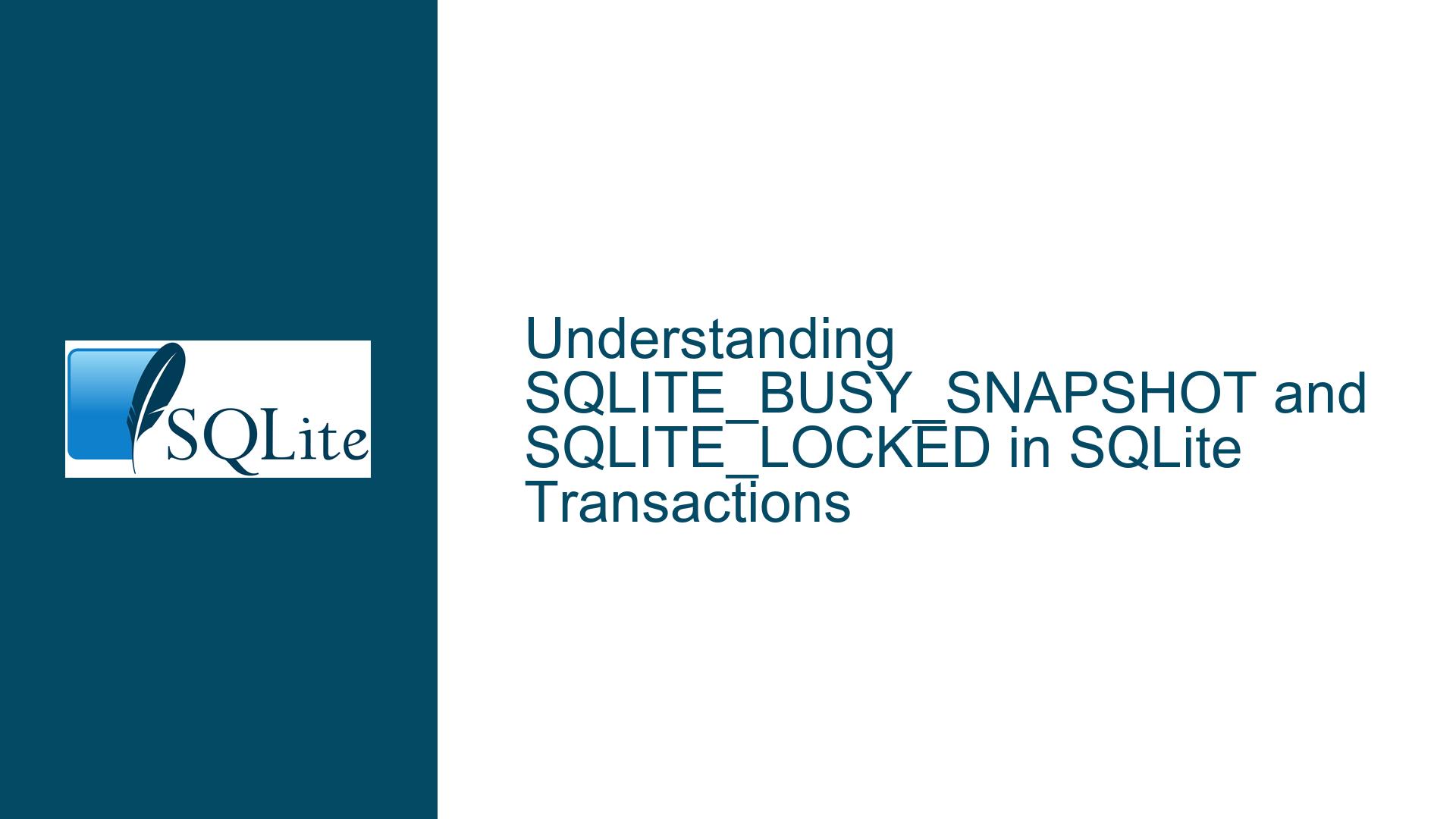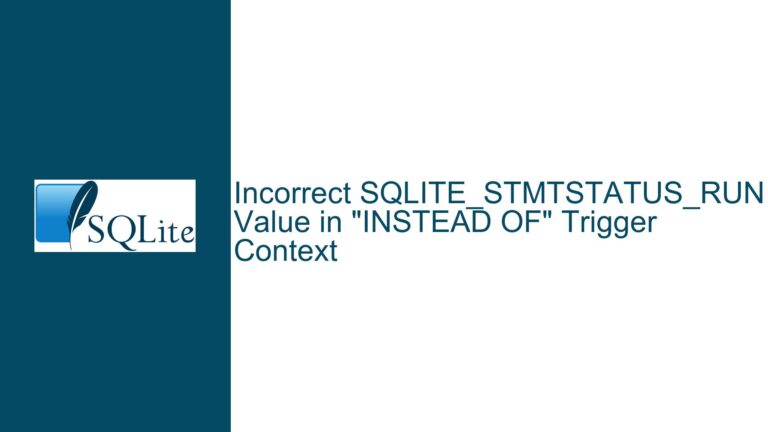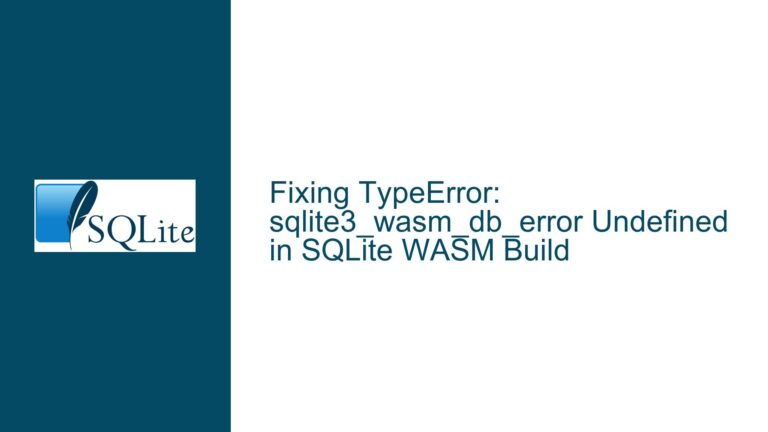SQLITE_BUSY_SNAPSHOT and SQLITE_LOCKED in SQLite Transactions
Issue Overview: SQLITE_BUSY_SNAPSHOT vs. SQLITE_LOCKED in Write Transaction Upgrades
When working with SQLite in WAL (Write-Ahead Logging) mode, developers may encounter locking issues when attempting to upgrade a read transaction to a write transaction. Specifically, the error SQLITE_BUSY is expected when another connection is modifying the database, but in some cases, the error SQLITE_LOCKED or its extended variant SQLITE_BUSY_SNAPSHOT is returned instead. This behavior can be confusing, especially when the documentation suggests that SQLITE_BUSY should be the expected error in such scenarios.
The core issue arises when a read transaction is initiated in one connection, and a second connection modifies the database. When the first connection attempts to upgrade its read transaction to a write transaction, it cannot proceed because the snapshot it holds is no longer at the top of the stack due to the modifications made by the second connection. This results in the SQLITE_BUSY_SNAPSHOT error, which is a specific case of SQLITE_BUSY. However, due to the way error messages are displayed in some tools (e.g., the SQLite CLI), the error might be misinterpreted as SQLITE_LOCKED, leading to further confusion.
This issue is particularly relevant in multi-connection environments where transactions are long-lived or where multiple connections are actively modifying the database. Understanding the nuances of these error codes and the conditions under which they occur is crucial for debugging and resolving such issues effectively.
Possible Causes: Why SQLITE_BUSY_SNAPSHOT Occurs Instead of SQLITE_BUSY
The primary cause of the SQLITE_BUSY_SNAPSHOT error lies in the way SQLite handles transactions in WAL mode. In WAL mode, SQLite allows multiple readers and a single writer to operate concurrently. However, certain constraints apply when upgrading a read transaction to a write transaction.
When a read transaction is initiated, SQLite takes a snapshot of the database at that point in time. This snapshot is used to ensure consistent reads throughout the transaction. If another connection modifies the database while the read transaction is still active, the snapshot held by the first connection becomes outdated. When the first connection attempts to upgrade its read transaction to a write transaction, it must ensure that its snapshot is still valid and at the top of the stack. If the snapshot is no longer valid (i.e., another connection has modified the database), the upgrade attempt fails with SQLITE_BUSY_SNAPSHOT.
This behavior is different from the standard SQLITE_BUSY error, which occurs when a connection attempts to acquire a write lock but cannot do so because another connection is actively writing to the database. In the case of SQLITE_BUSY_SNAPSHOT, the issue is not just about acquiring a write lock but also about the validity of the snapshot held by the transaction.
Another contributing factor to the confusion is the way error messages are displayed in some SQLite tools. For example, the SQLite CLI might display a generic "database is locked" message without indicating the specific error code (SQLITE_BUSY_SNAPSHOT). This can lead developers to misinterpret the error as SQLITE_LOCKED, which is a different error code with different implications.
Troubleshooting Steps, Solutions & Fixes: Resolving SQLITE_BUSY_SNAPSHOT Issues
To effectively troubleshoot and resolve issues related to SQLITE_BUSY_SNAPSHOT, developers need to understand the underlying causes and adopt strategies to handle these errors gracefully. Below are detailed steps and solutions to address this issue:
1. Identify the Correct Error Code
The first step in troubleshooting is to ensure that you are correctly identifying the error code. As demonstrated in the discussion, the SQLite CLI might display a generic "database is locked" message without specifying the exact error code. To accurately diagnose the issue, you should use a programming language or tool that provides access to the extended error codes.
For example, using Python with the apsw library, you can capture the extended error code as follows:
import apsw
db = apsw.Connection('test.db')
db.begin()
try:
db.execute('update test set note = "bar" where note = "hello"')
except apsw.BusyError as e:
print(f"Error: {e}, Extended Error Code: {e.extendedresult}")
In this example, the extended error code will be 517, which corresponds to SQLITE_BUSY_SNAPSHOT. This level of detail is crucial for understanding the exact nature of the error and taking appropriate action.
2. Handle SQLITE_BUSY_SNAPSHOT Gracefully
Once you have identified the SQLITE_BUSY_SNAPSHOT error, the next step is to handle it gracefully in your application. Since this error indicates that the snapshot held by the transaction is no longer valid, the most straightforward approach is to restart the transaction.
Here’s how you can implement a retry mechanism in Python:
import apsw
import time
def update_note():
db = apsw.Connection('test.db')
retries = 3
for attempt in range(retries):
try:
db.begin()
db.execute('update test set note = "bar" where note = "hello"')
db.commit()
break
except apsw.BusyError as e:
if e.extendedresult == 517: # SQLITE_BUSY_SNAPSHOT
db.rollback()
time.sleep(1) # Wait for a second before retrying
else:
raise
finally:
db.close()
update_note()
In this example, the transaction is retried up to three times if a SQLITE_BUSY_SNAPSHOT error is encountered. The time.sleep(1) call introduces a delay between retries, which can help reduce contention in a busy system.
3. Optimize Transaction Management
To minimize the occurrence of SQLITE_BUSY_SNAPSHOT errors, it’s important to optimize how transactions are managed in your application. Here are some best practices:
Keep Transactions Short-Lived: Long-lived transactions increase the likelihood of conflicts with other connections. Where possible, keep transactions short and focused on specific tasks.
Use Explicit Transactions: Always use explicit
BEGIN,COMMIT, andROLLBACKstatements to control transaction boundaries. This ensures that transactions are properly managed and reduces the risk of unexpected behavior.Avoid Unnecessary Upgrades: If a transaction only needs to read data, avoid upgrading it to a write transaction unless absolutely necessary. This reduces the chances of encountering
SQLITE_BUSY_SNAPSHOTerrors.
4. Monitor and Analyze Database Activity
In a multi-connection environment, monitoring and analyzing database activity can help identify patterns that lead to SQLITE_BUSY_SNAPSHOT errors. Tools like SQLite’s sqlite3_profile function or third-party monitoring solutions can provide insights into how transactions are interacting with the database.
For example, you can use the following SQLite CLI commands to monitor active transactions:
PRAGMA database_list;
PRAGMA wal_checkpoint;
These commands provide information about the current state of the database and the WAL file, which can help identify contention points.
5. Consider Alternative Concurrency Models
If SQLITE_BUSY_SNAPSHOT errors are frequent and significantly impact your application’s performance, it may be worth considering alternative concurrency models. For example, you could use a connection pool to limit the number of concurrent connections or implement a queueing system to serialize write operations.
Additionally, if your application requires high levels of concurrency, you might explore other database systems that offer more advanced concurrency control mechanisms. However, for many use cases, SQLite’s WAL mode provides a good balance between performance and simplicity.
6. Enhance Error Reporting in Tools
As suggested in the discussion, enhancing error reporting in tools like the SQLite CLI can help developers more easily diagnose issues. For example, displaying extended error codes and the context in which errors occur (e.g., during PREPARE or STEP) can provide valuable debugging information.
If you are using a custom application or tool that interacts with SQLite, consider implementing similar enhancements to improve error reporting. This can save significant time when troubleshooting issues like SQLITE_BUSY_SNAPSHOT.
By following these troubleshooting steps and solutions, developers can effectively address SQLITE_BUSY_SNAPSHOT errors and ensure that their SQLite-based applications run smoothly in multi-connection environments. Understanding the nuances of SQLite’s transaction handling and error reporting is key to building robust and reliable database applications.






